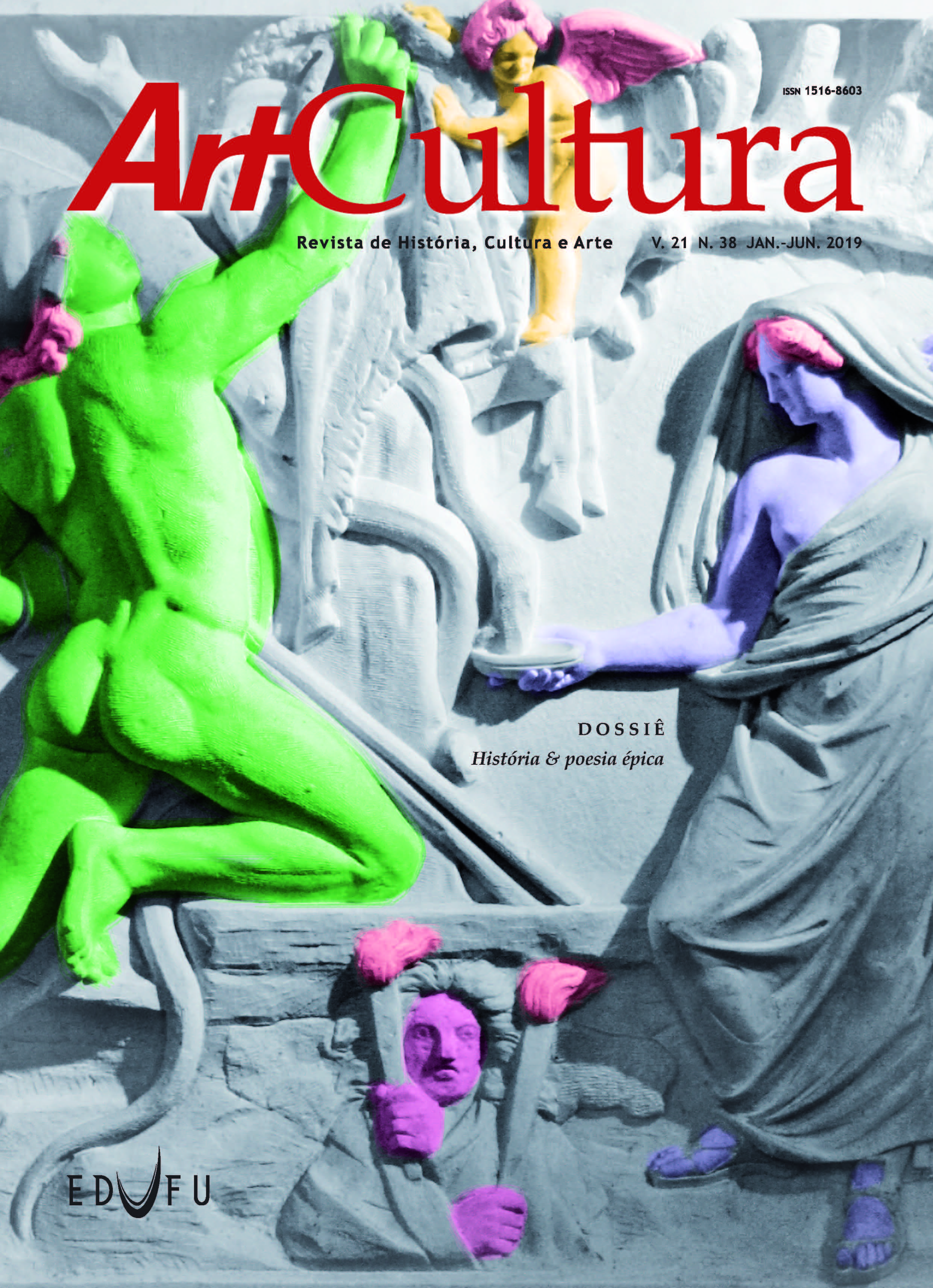is the “Epic of gilgamesh” an epopee?
DOI:
https://doi.org/10.14393/artc-v21-n38-2019-50156Keywords:
Gilgamesh epic, Greek epic, third-person autobiographyAbstract
As the Gilgamesh’s poem existed in its own world, as well in ours, this paper discusses the pertinence of applying to him the epic label. From the modern pointo of view, this gender classification depends on the approach to the archaic Greek epic, and responds to the need to situate the text in a constellation of known genres, guiding its reception. From the ancient Babylonian perspective, the epic label seems inadequate, and I propose to understand the poem as the literary counterpart of a narû, of what is called “third-person autobiography”.
Downloads
References
BOUZON, Emanuel. O código de Hammurabi. Introdução, tradução do texto cuneiforme e comentários de Emanuel Bouzon. 4. ed. Petrópolis: Vozes, 1987.
BRANDÃO, Jacyntho Lins. No princípio era a água. Revista da UFMG, v. 20, n. 2, 2013.
BRANDÃO, Jacyntho Lins. Qual romance? (entre antigos e modernos). Eutomia, v. 12, 2013.
BURKERT, Walter. The orientalizing revolution: Near Eastern influence in Greek culture in the early archaic age. Cambridge: Harvard University Press, 1995.
DALLEY, Stephanie. Myths from Mesopotamia: Creation, The Flood, Gilgamesh and others. Oxford: Oxford University Press, 2008.
EDZARD, Dietz Otto. Sumerian epic: epic or fairy tale. Bulletin of the Canadian Society for Mesopotamian Studies, v. 27, 1994.
GEORGE, Andrew R. Gilgamesh and the literary traditions of ancient Mesopotamia. In: LEICK, Gwendolyn (ed.). The Babylonian world. New York: Routledge, 2007.
GEORGE, Andrew R. The Babylonian Gilgamesh epic: introduction, critical edition and cuneiform texts. Oxford: Oxford University Press, 2003.
GEORGE, Andrew R. The epic of Gilgamesh: thoughts on genre and meaning. In: AZIZE, J., WEEKS, N. (ed.). Gilgamesh and the world of Assyria: proceedings of the conference held at the Mandelbaum House, the University of Sidney, 21-23 July 2004. Leuven: Peters, 2007.
GEORGE, Andrew R. The Gilgameš epic at Ugarit. Aula Orientalis, v. 25, 2007.
GEORGE, Andrew R. The mayfly on the river: individual and collective destiny in the epic of Gilgamesh. Kaskal, rivista di storia, ambienti e culture del Vicino Oriente Antico, v. 9, 2012.
HAUPT, Paul. Das Babylonische Nimrodepos. Leipzig: Hinrichs, 1884.
HEIDEL, Alexander. The Gilgamesh Epic and Old Testament parallels. Chicago: The University of Chicago Press, 1963.
HERODOTUS. Herodotus’ History. 2, 116. Ed. A. D. Godley. Cambridge: Harvard University Press, 1961.
HOMERO. Ilíada. II, 484-493. São Paulo: Penguin Classics/Companhia das Letras, 2013.
HOMERO. Odisseia. 8, 578-580. São Paulo: CosacNaify, 2014.
JEREMIAS, Alfred. Izdubar-Nimrod: eine altbabylonische Heldensage. Leipzig: Teubner, 1891.
LAMBERT, Wilfred G. A catalogue of texts and authors. Journal of Cuneiform Studies, n. 16, 1962.
MICHALOWSKI, Piotr. Commemoration, writing, and genre in ancient Mesopotamia. In: KRAUS, S. (ed.). The limits of Historiography: genre and narrative in ancient historical texts. Leiden: Brill, 1999.
NOVAES, José de Campos. As origens chaldeanas do judaismo. São Paulo: Typographia Brazil de Carlos Gerke e Cia., 1899.
SASSON, Jack M. Prologues and poets: on the opening lines of the Gilgamesh epic. In: COLLINS, Billie Jean e MICHALOWSKI, Piotr. Beyond Hatti: a tribute to Gary Beckman. Atlanta: Lockwood Press, 2013.
SMITH, George. The chaldean account of Genesis. New York: Scriber, Armstrong & Co., 1876.
TSAGARAKIS, Odysseus. Studies in Odyssey 11. Stuttgart: Franz Steiner Verlag, 2000.
VANSTIPHOUT, Herman L. J. Some thoughts in genre in Mesopotamian literature. In: HECKER, K., SOMMERFIELD, W. Keilschriftliche Literaturen. Berlin: D. Reimer, 1986.
WEST, Martin L. Indoeuropean poetry and myth. Oxford: University Press, 2007
WEST, Martin Lichtfield. The rise of greek epic. Journal of Hellenic Studies, v. 108, 1988.
WEST, Martin L. Prolegomena. In: HESIOD. Theogonia. Edited, with prolegomena and commentary by M. L. West. Oxford: Clarendon, 1966.
Downloads
Published
How to Cite
Issue
Section
License
Autores que publicam nesta revista concordam com os seguintes termos da licença Creative Commons, adotada a partir da ArtCultura, v. 21, n. 39 (jul.-dez. 2019).
CC BY-NC-ND 4.0: o artigo pode ser copiado e redistribuído em qualquer suporte ou formato. Os créditos devem ser dados ao autor original e mudanças no texto devem ser indicadas. O artigo não pode ser usado para fins comerciais. Caso o artigo seja remixado, transformado ou algo novo for criado a partir dele, ele não pode ser distribuído.
Autores têm autorização para assumir contratos adicionais separadamente, para distribuição não exclusiva da versão do trabalho publicada nesta revista (ex.: publicar em repositório institucional ou como capítulo de livro), com reconhecimento de autoria e publicação inicial nesta revista.


